Azipod
-
- ABB: Propelling the Polar Cruise Boom Maritime Reporter, Feb 2017 #26
ABB Azipods help to propel a new generation of Arctic capable cruise ships
Leveraging its experience in the distinct polar and cruise vessel segments, ABB and its Azipod are at the forefront of the booming polar passenger vessel market. As world travelers continually seek access to more exotic and exciting destinations, evolving cruise shipping trends have triggered an order boom for passenger vessels capable of plying some of the most treacherous Arctic and Antarctic routes. Required for this class of ships is a range of equipment and technologies that enable safe and comfortable sailing through polar waters. Answering the propulsion call is ABB, a world leader within the polar and passenger vessel markets, whom Maritime Reporter & Engineering News recently visited at its Helsinki location, ABB Marine House.ABB’s electric podded azimuth thruster Azipod has a 25-year history in the maritime industry, serving a large variety of vessel types ranging from cargo ships to offshore support vessels and drill ships. No stranger to icy conditions, ABB’s know-how for ice going vessels runs deep, and the company possesses a long supply history for cold water vessels. Currently there are more than 60 Azipod-equipped vessels in operation or on order for work in icy waters, including the high-tech LNG-powered Finnish icebreaker Polaris delivered last year, and SCF’s 299-meter heavy ice class LNG carrier Christophe de Margerie.Likewise, ABB is no stranger to cruise and passenger ships. Azipods were first installed on a cruise ship in 1998, paving way for some 60 subsequent cruise ships to date, including the world’s largest: Royal Caribbean’s 1,187-foot-long, 226,000-gross-ton Oasis class ships. In the cruise market, ABB’s most recent Azipod order came from Genting’s Star Cruises brand, whose two new 204,000-gross-ton Global Class vessels due for delivery from 2019 are specially designed for the Asian cruise market.Of all modern large cruise ships, icebreakers and high ice-class cargo vessels, roughly two-thirds are fitted with Azipod propulsion, according to ABB. “The main market for Azipod is large cruise and the opening new seaways in the north,” said Sakari Sorsimo, Senior Vice President, Head of ABB Business Unite Marine and Ports Finland.Leveraging this presence and experience in both the polar and cruise segments, ABB is now positioned to serve an emerging class of polar and sub polar passenger vessels and has even launched a new Azipod designed specifically this market, the Azipod DO, which Sorsimo said is designed for “smaller, lighter ice class vessels,” and is available from 1.5-7.5 MW.“We are designing [the Azipod DO] here in Finland, but manufacturing in China,” Sorsimo said. “And for this, we already have contracts for polar cruise vessels.”In the expedition cruise segment, ABB currently has orders to supply Azipods for the world’s first passenger vessel to be constructed explicitly to Polar Code standards, and most recently the world’s largest expedition yachts with ice class.The polar class passenger vessel Scenic Eclipse is currently under construction at Croatia’s Uljanik shipyard for Australia’s Scenic group and is due for delivery in August 2018. The 10-deck luxury cruiser will be outfitted with two 3 MW Azipod units, propelling the 168-meter-long, 16,800-gross-ton vessel through polar waters during the summer months. Scenic Eclipse will be classed by Bureau Veritas.Three new 20,000-gross-ton expedition megayachts for Genting Hong Kong brand Crystal Cruises will each be powered by two Azipod units, enabling the Polar Class 6 luxury ships to navigate in icy conditions. The three Endeavor Class vessels will be built by MV Werften in Germany starting in 2017 and delivered in 2019, 2020 and 2021. ABB will supply the complete power, propulsion and automation package for these vessels, each classed by DNV GL.“We are doing quite high ice class on the DO pod, so we have a unit that has to perform both in the ice and in the open water with extremely high comfort,” said Marcus Höglblom, ABB Vice President for Passenger Ship and Azipod Segment. “These vessels will be able to cruise anywhere in the world – from Antarctic to Arctic – for a very demanding customer.”ABB AZipod DOPower range:- 1.5-7.5 MW per unit
Gearless power train- Induction motor, or
- Permanent magnet motor
Hybrid cooling- Up to 45% performance increase
- Up to 70% power without cooling
Electric steering- 4 redundancy options
Adjustable strut height- Minimizes / eliminates headbox
Shaftline proven technology- Redundant seal
- Online bearing monitoring
(As published in the February 2017 edition of Maritime Reporter & Engineering News) -
- ABB's New Azipod Thruster Maritime Reporter, Apr 2015 #99
ABB has released details on its latest generation Azipod thruster, a unit which ranges in power from 1.6 megawatts to 7 megawatts (MW) and is intended to serve a growing electric propulsion market. (According to Clarkson’s Research, the number of vessels with electric propulsion has been growing at a pace
-
- Podded Propulsion Goes Beyond the Cruise Realm Maritime Reporter, Jul 2001 #44
, and underscoring a propensity for maritime innovation, the Finns were the leaders in the podded drive concept. The first contractual reference for the Azipod system originated by ABB Industry and Kvaerner Masa- Yards (KMY) gave the design its operational debut in 1991. While various specialized vessels
-
- Pods for a rising market Maritime Reporter, Sep 2000 #31
the business momentum and broaden the market reach for the technology, Finnish electrical engineering innovator ABB PODS Industry is promoting a new Azipodderived design bred specifically for smaller vessel types. While the main Azipod series has been engineered for unit powers up to 25- MW, the recently
-
- NORSHIPCO Performs Pod Repair Maritime Reporter, Feb 2002 #30
. When contacted by Holland America to discuss the vessel's drydocking, NORSHIPSCO then began to train its personnel to complete warranty repairs on the azipod propulsion system in an extremely short availability on the drydock. The vessel's azipod propulsion system, manufactured by ABB, are selfcontained syst
-
- New Cruise Ship Designs Impact Terminal Ops And Logistics Maritime Reporter, Feb 2000 #31
not readily visible, they are nonetheless equally essential to support these massive ships. An excellent example of this relates to the impact of Azipod propulsion systems upon the structural integrity of retaining walls and piles. The Azipod systems that are increasingly finding their way onto
-
- Finnish Innovation Ascends New Heights Maritime Reporter, Feb 2000 #50
domain as regards marine engineering technology, expressed in her refined diesel-electric power and propulsion system incorporating a triple Azipod configuration. Voyager of the Seas is emphatically also a new showcase for the concept of redundancy, applied to the main shipboard operating systems
-
- NNS Fixes Circle 278 on Reader Service Card ISO 9001 CERTIFIED 8365 Highway 308 South • Lockport, Louisiana 70374 Telephone: (504) 532-2554 • Fax: (504) 532-7225 • www.bollingershipyards.com Paradise s Pod Maritime Reporter, Sep 2000 #32
When the 70,367-ton, 855 - f t . (260.6 m) Carnival Paradise arrived at Newport News Shipbuilding for emergency repair on its Azipod propulsion system, it marked a mile- stone in ship repair history as no U.S.- based yard had ever performed work on the advanced pod system. The vessel arrived
-
- ABB's Compact Pod Makes Mark In $42M Deal Maritime Reporter, Aug 2001 #35
rig includes a complete package solution consisting of generators, high and low voltage switchboards, drilling and propulsion drives and eight Compact Azipod podded propulsion units with a total output of 25.6 MW. In total, ABB has delivered electrotechnical solutions to more than 50 drilling vessels
-
- NorseMerchant Ferries Plans Service Upgrade Maritime Reporter, Mar 2004 #37
run. but this arrangement allows for one engine to be out of service for maintenance. • The Mariner of the Seas has three azimuthing electric 14 MW Azipod units. The two units on the sides are fully azimuthing whereas the one at the centerline is a fixed Azipod unit. The Mariner of the Seas has been desig
-
- Ultra Large Containerships: Will Security Measures Impede Operations? Maritime Reporter, Aug 2002 #43
solution. Last year ABB and Samsung teamed to develop a new propulsion con- cept for Samsung's 12,000 TEU container ships. In comparing the CRP Azipod solution to two other propulsion systems — a single engine and a twin main engine — tests conducted at Samsung's Ship Model Basin found that the
-
- A 360 O Maritime Reporter, Feb 2003 #38
said Kulovaara. "The pods are essential ... without them, the maneuverability would not be there." Navigator features three azimuthing electric 14 MW Azipod units, two that are fully azimuthing with one fixed centerline unit. Pushing and Pulling The advent of podded propulsions for shipboard applications
-
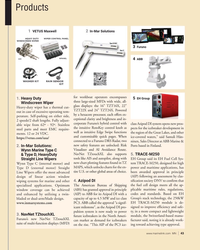 )
April 2024 - Marine News page: 43
)
April 2024 - Marine News page: 43clarity and brightness and in- 2 speeds/2 shaft lengths. Fully adjust- able wipe from 62º - 92º. Stainless corporate Furuno’s hybrid control with class Azipod DI system opens new pros- the intuitive RotoKey control knob as pects for the icebreaker development in steel parts and meet EMC require- well as
-
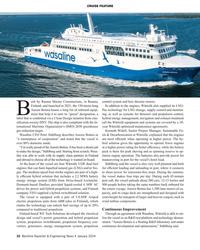 )
January 2024 - Maritime Reporter and Engineering News page: 32
)
January 2024 - Maritime Reporter and Engineering News page: 32VEO supplied a hybrid switchboard solution. pacity, and its cargo deck are strengthened and designed with The vessel is equipped with a pair of 5.8-MW Azipod extra height for transport of larger and heavier cargoes such as electric propulsion units from ABB (also in Finland), which wind turbine components
-
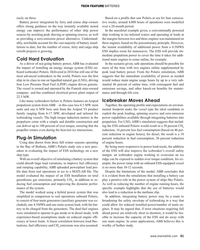 )
June 2023 - Maritime Reporter and Engineering News page: 41
)
June 2023 - Maritime Reporter and Engineering News page: 41and has combined electrical power plant output of nance and through-life cost. 22.5 MW. Like many icebreakers before it, Polaris features an Azipod Icebreaker Moves Ahead propulsion system from ABB – in this case two 6.5 MW stern Together, the operating pro? le and expectations on environ- units
-
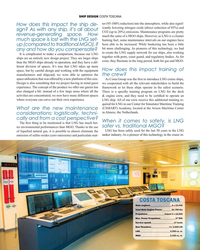 )
September 2022 - Maritime Reporter and Engineering News page: 44
)
September 2022 - Maritime Reporter and Engineering News page: 44of sulfur oxides (zero emissions) and particulate mat- COSTA TOSCANA Main engines: 4 x 15,440 Total Main Engine Power: 61,760 Kw Propulsion: Azipod 2 x 18,500 Max. Power Propulsion: 37 MW Service speed: 17 knots Bow Thrusters: 4 x 3,500 kW LNG 3,350 cu. m. MGO 2,100 cu. m. Photo courtesy Costa
-
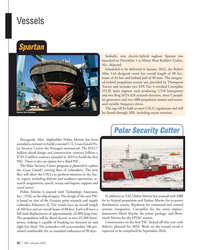 )
January 2022 - Marine News page: 40
)
January 2022 - Marine News page: 40. The design of the new PSC In addition to TAI, Halter Marine has teamed with ABB is based on that of the German polar research and supply for its Azipod propulsion and Trident Marine for its power icebreaker Polarstern II. The vessels have an overall length distribution system, Raytheon for command
-
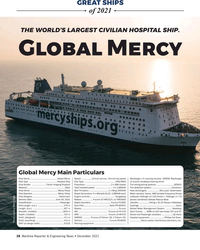 )
December 2021 - Maritime Reporter and Engineering News page: 28
)
December 2021 - Maritime Reporter and Engineering News page: 28windlass/mooring winch Ship Builder ........................Tianjin Xingang Shipyard Propulsion: ...........................................2 x ABB Azipod Fire extinguishing systems: .............................SEMCO Material ..................................................................Steel
-
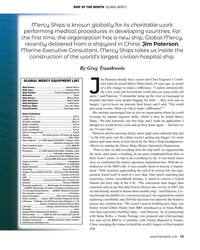 )
September 2021 - Maritime Reporter and Engineering News page: 19
)
September 2021 - Maritime Reporter and Engineering News page: 19cabins weren’t getting any bigger,” he came Fuel Type: ...............................................................HFO/ MGO Main engines: ...2 x ABB Azipod CO1400L 4 blades 3.8m ashore and made home in East Texas by the Mercy Ships headquarters, ...................................................
-
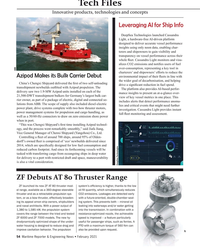 )
February 2021 - Maritime Reporter and Engineering News page: 54
)
February 2021 - Maritime Reporter and Engineering News page: 54CO2 emissions and noti? es users of fuel over-consumption, representing a key tool in ABB charterers’ and shipowners’ efforts to reduce the Azipod Makes its Bulk Carrier Debut environmental impact of their ? eets in line with the wider goal of decarbonisation, and helping China’s Chengxi Shipyard
-
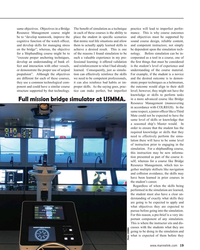 )
October 2020 - Maritime Reporter and Engineering News page: 19
)
October 2020 - Maritime Reporter and Engineering News page: 19and interaction with other vessels, and reinforcement to what I had already is the student’s level of experience and or demonstrate the proper use of azipod learned. Consequently, just as simula- understanding of the course material. propulsion”. Although the objectives tion can effectively reinforce
-
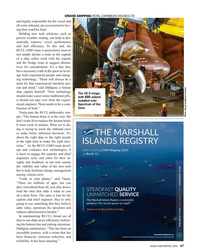 )
March 2020 - Maritime Reporter and Engineering News page: 47
)
March 2020 - Maritime Reporter and Engineering News page: 47per- son and mind,” said Dahlgren, a former ship captain himself. “New technology The 20.5-mega- should make easier some traditional jobs, watt ABB azipod it should not take over from the experi- installed onto enced engineer. There needs to be a com- Spectrum of the Seas. bination of both.” Tuteja
-
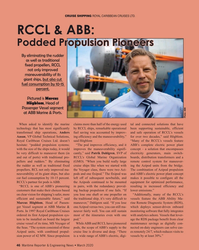 )
March 2020 - Maritime Reporter and Engineering News page: 46
)
March 2020 - Maritime Reporter and Engineering News page: 46. “When you build really large remote control system for maneuver- the rudder as well as traditional fixed cruise ships like when we started with ing the Azipod units from the bridge. propellers, RCL not only improved ma- the Voyager class, there were two Azi- The combination of Azipod propulsion neuverability
-
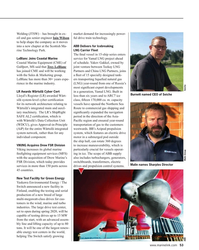 )
January 2020 - Maritime Reporter and Engineering News page: 53
)
January 2020 - Maritime Reporter and Engineering News page: 53ensured year-round (WDCU), gives Approval-in-Principle transportation of gas to the customers (AiP) for the entire Wärtsilä integrated westwards. BB’s Azipod propulsion system network, rather than for any system, which features an electric drive individual component. motor in a submerged pod outside
-
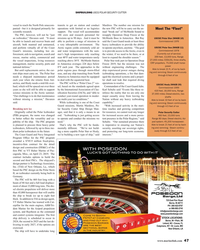 )
November 2019 - Maritime Reporter and Engineering News page: 47
)
November 2019 - Maritime Reporter and Engineering News page: 47eight feet thick. In addition to TAI as design agent, VT Halter Marine has teamed with Cat- erpillar for the main engines, ABB/Tri- dent Marine for the Azipod propulsion system, and Raytheon as the command and control systems integrator. The ? rst ship delivery is scheduled to occur in 2024, the second
-
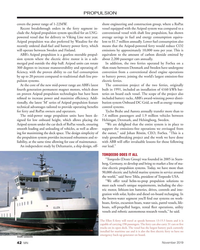 )
November 2019 - Marine News page: 42
)
November 2019 - Marine News page: 42range of 1-22MW. shore engineering and construction group, where a RoPax Recent breakthrough orders in the ferry segment in- vessel equipped with the Azipod system was compared to a clude the Azipod propulsion system speci? ed for an LNG- conventional vessel with shaft line propulsion, has shown powered
-
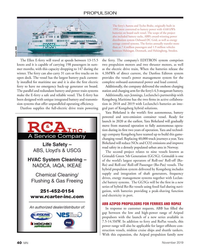 )
November 2019 - Marine News page: 40
)
November 2019 - Marine News page: 40a new series of hybrid Ro-Ro vessels using fossil fuel during navi- gation, with batteries providing a peak-shaving function and electricity in port. ABB AZIPOD PROPULSORS FOR FERRIES AND ROPAX In response to customer requests, ABB has ? lled the gap between the low and high-power range of Azipod propulsors
-
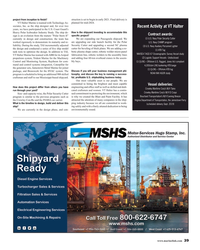 )
August 2019 - Maritime Reporter and Engineering News page: 39
)
August 2019 - Maritime Reporter and Engineering News page: 39TAI, botic plasma shape cutter, robotic welder micro-panel NAVSEA T-AGS 67 Oceanographic Survey Vessel study VT Halter Marine has teamed with ABB for its Azipod fabrication line, robotic welders to the assembly lines (2) Logistic Support Vessels - Undisclosed propulsion system, Trident Marine for the Machinery
-
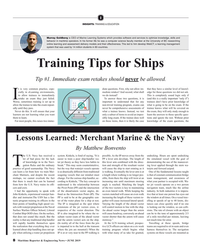 )
June 2019 - Maritime Reporter and Engineering News page: 8
)
June 2019 - Maritime Reporter and Engineering News page: 8wa- practice of good seamanship. The Navy but the way that waterjet vessels operate will cause the ship to start rotating as it terjets and forward azipod. can learn a lot from how we train Mer- is so drastically different from traditional is walking. Eventually the lever arm is at One of the fundamental
-
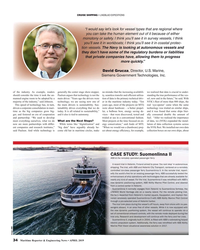 )
April 2019 - Maritime Reporter and Engineering News page: 34
)
April 2019 - Maritime Reporter and Engineering News page: 34only. Research and development will continue with the ferry and her crew. Suomenlinna II, originally built in 2004, is ? tted with ABB’s icebreaking Azipod electric propulsion system. Additionally, the ferry was retro? tted with ABB Ability Marine Pilot Vision situational awareness solution in 2017
-
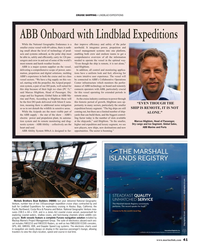 )
March 2019 - Maritime Reporter and Engineering News page: 41
)
March 2019 - Maritime Reporter and Engineering News page: 41. The vessel will vessel sectors. “We have a big supply on this ves- be connected to ABB’s Collaborative Operations sel, starting with the propeller, the Azipod propul- Center infrastructure which monitors the perfor- sion system, a pair of our DO pods, well suited for mance of ABB technology on board and
-
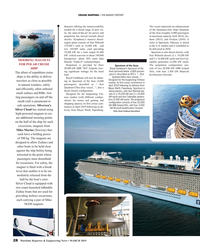 )
March 2019 - Maritime Reporter and Engineering News page: 28
)
March 2019 - Maritime Reporter and Engineering News page: 28generators (2,500 kW each). FOR POLAR CRUISE Propulsion is provided by three The propulsion con? guration con- Spectrum of the Seas 20,000 kW ABB “XO” Azipods, leav- sists of two 20,500 kW ABB Azipod Royal Caribbean’s Spectrum of the SHIP Seas (pictured below, 4,800 passen- ing signi? cant wattage for
-
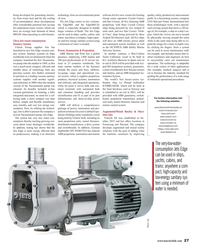 )
September 2018 - Maritime Reporter and Engineering News page: 27
)
September 2018 - Maritime Reporter and Engineering News page: 27these technologies work, with a special- for exploration cruise vessels, which can which is especially designed to handle ships being powered by two Azipod D ized viewing system that shows a 3D im- have an average heat demand of about larger volumes of ? uids. The Jets Edge units each, and two Star
-
 )
August 2018 - Maritime Reporter and Engineering News page: 93
)
August 2018 - Maritime Reporter and Engineering News page: 93from OSO HOTWATER AS the DC switchboard and, when braking, Supplier of energy is fed back into the power system. *[FTQRJQTGCPFECNQTKRGTU The three ABB Azipod thrusters in- HQTOCTKPGCPFQoUJQTG stalled are among 36 vessel components generating over 1,500 signals and a dai- ly 80MB data package for analysis
-
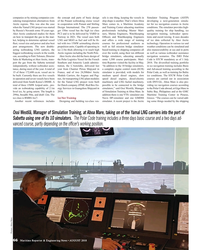 )
August 2018 - Maritime Reporter and Engineering News page: 66
)
August 2018 - Maritime Reporter and Engineering News page: 66South Korea’s DSME. A for the Yamal LNG project were built machinery and LNG fueled machinery, with DNV-GL. Aboa Mare is also pro- total of three 15MW Azipod units , pro- for Dutch company ZPMC-Red Box En- possible to be connected to the bridge viding ice navigation courses according vide an icebreaking
-
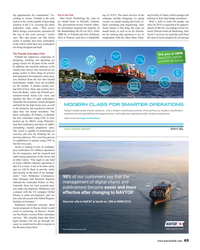 )
August 2018 - Maritime Reporter and Engineering News page: 65
)
August 2018 - Maritime Reporter and Engineering News page: 65rst icebreaker using LNG as fuel, Learn more at dnvgl.com/maritime backed up by MGO, using Wärtsilä’s dual-fuel machinery and three of ABB’s azimuthing Azipod propulsion units. The vessel is capable of performing oil recovery and also for breaking the ice moving sideways. The vessel has proven its capabilities
